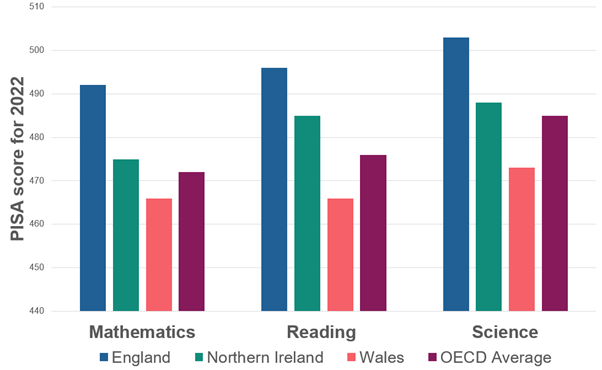The Programme for International Student Assessment (PISA) is a worldwide study that assesses the knowledge and skills of 15-year-old students in mathematics, reading and science. PISA facilitates comparisons of performance between education systems (usually different countries) and over time, between PISA cycles. For this reason, PISA results often have a strong influence on education policymaking.
Deanery Digests are short, plain language summaries of the Department of Education’s research outputs. This Deanery Digest is based on the following three open-access reports: Ingram, J.; Stiff, J., Cadwallader S., Lee, G. & Kayton, H (2023) PISA 2022: National Report for England. Department for Education. Available from https://www.gov.uk/government/publications/pisa-2022-national-report-for-england ; Ingram, J.; Stiff, J., Cadwallader S., Lee, G. & Kayton, H (2023) PISA 2022: National Report for Northern Ireland. Department for Education. Available from https://www.education-ni.gov.uk/articles/programme-international-student-assessment-pisa ; Ingram, J.; Stiff, J., Cadwallader S., Lee, G. & Kayton, H (2023) PISA 2022: National Report for Wales. Welsh Government. Available from https://www.gov.wales/achievement-15-year-olds-program-international-student-assessment-pisa-national-report-2022
What is this research about and why is it important?
What did we do?
- PISA is developed and organised internationally by the Organisation for Economic Co-operation and Development (OECD) and delivered in England, Wales and Northern Ireland by Pearson.
- In 2022, 81 education systems took part globally, and the United Kingdom was represented by nearly 13,000 students from more than 450 schools. Here, at the University of Oxford’s Department of Education, we analysed the data and produced the national reports for each of England, Northern Ireland and Wales.
- This digest provides a summary of what we found in relation to the performance of students in PISA 2022. We consider how the three nations compare internationally, how their performance has changed over time, and the extent to which performance varies by gender and socio-economic status.
What did we find?
- The graph below (Figure 1) shows the scores for each nation in each subject, along with OECD average scores.
Figure 1: PISA 2022 scores for England, Northern Ireland, Wales and the OECD on average in mathematics, reading and science

- The average score of students in England was significantly above the OECD international average for each of mathematics, reading and science. The average score of students in Northern Ireland was similar to the OECD average score for each of mathematics and science, but significantly above the OECD average for reading. In the case of Wales, average student scores were significantly lower than the OECD average scores for all three subjects. Please note that when we use the word “significant, we are referring to statistical significance. Statistically significant differences are likely to reflect a true difference between the groups that are being compared (and less likely to reflect sampling or measurement error).
- The nature of the PISA study allows performance in 2022 to be compared to performance in previous PISA cycles, the last of which was in 2018. Across the education systems measured by the OECD globally, science scores remained similar to 2018, but scores in mathematics and reading were significantly lower. This was echoed in the results of England and Northern Ireland, with science scores remaining stable relative to 2018, but mathematics and reading scores being lower. In Wales, average scores in all three subjects were significantly lower than they were in 2018. In summary, overall performance levels in PISA have, in general, declined globally since 2018.
- Students from relatively disadvantaged socio-economic backgrounds had, on average, significantly lower scores than those from relatively less disadvantaged backgrounds across all three subjects and in all three nations. This is, perhaps unsurprisingly, in line with international trends. The difference between the average scores of students from the most and least disadvantaged backgrounds was smaller in Wales than it was on average across OECD countries for all subjects. This was also true for mathematics and reading in the case of Northern Ireland.
- Gender differences in performance had the same pattern in all three nations: boys had a significantly higher average score than girls for mathematics and girls had a significantly higher average score than boys for reading. Gender differences in science were not significant in PISA 2022.
- The highest performing education systems are generally in East Asia, particularly for mathematics and science. Students in Singapore, in particular, scored significantly higher on average in all subjects than students from the other participating education systems. The average performance of students from Japan, Taiwan, Macao and South Korea was also relatively high across the three subjects.
What does it all mean anyway?
- PISA results must be considered in the context of their limitations – particularly in this instance, because an analysis of the response rate (those schools and students who were sampled relative to those who actually took part) suggests that the findings may not generalise to the population as well as we would like. It is also tempting to look at how countries ‘rank’ against each other, but this too is inadvisable because PISA can only estimate the performance of students on the basis of the sample of 15-year-old students that participated in each education system. There is therefore uncertainty around the scores that makes using them for something as precise as ranking education systems potentially misleading.
- All of that said, PISA does provide information about how the mathematics, reading and science knowledge and skills of students in different education systems compare. There is strong evidence that the international average performance was lower in 2022 than in previous cycles, which does suggest that global factors, most prominently the COVID-19 pandemic, are likely to have disrupted the education of young people all over the world. By providing a common metric over time and across countries, PISA provides a powerful tool for monitoring such trends. Such information, when combined with other sources of evidence, can be very useful for policy makers and teachers.
Open access reports
For those interested in further detail, the full national reports for England, Northern Ireland and Wales can be downloaded from the following websites:
- Department for Education (England)
- Department of Education (Northern Ireland)
- Welsh Government (Wales), in English and Cymraeg

